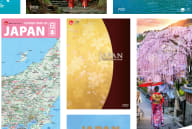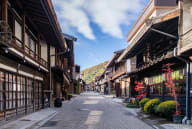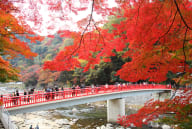
Shizuoka Fresh catches and fragrant teas await
A Culinary Journey in Shizuoka
Shizuoka Prefecture, nestled between Mt. Fuji and the Pacific Ocean, is a land where natural beauty and culinary excellence converge. With its varied geography and temperate climate, Shizuoka offers an abundant array of agricultural and marine products that are celebrated across Japan.
Renowned for its exceptional green tea, Shizuoka is the leading producer in Japan, where the region’s pristine environment and expert cultivation practices result in tea leaves of outstanding quality and flavour. The prefecture's fertile plains also yield a variety of fresh produce, including strawberries, melons, and wasabi, the latter flourishing in the clear, cold waters of the region.
Shizuoka's coastal location provides access to some of the finest seafood in Japan, particularly its succulent tuna from the port of Shimizu, which is a staple of the local cuisine. Another seafood highlight is Sakura shrimp, small, translucent shrimp that are harvested in Suruga Bay and enjoyed in various dishes for their delicate taste.
Traditional foods such as Shizuoka oden, a unique take on the classic Japanese stew featuring a dark broth flavoured with local soy sauce and miso, and Fujinomiya yakisoba, a stir-fried noodle dish from the city of Fujinomiya, add to the prefecture's rich culinary tapestry.
Experience Shizuoka's flavours, where each meal reflects the region’s natural bounty and heritage, offering a gastronomic journey rich in tradition and natural goodness.
Una-ju (Eel box)

What it is (Ingredients)
Una-ju is a classic Japanese dish from Shizuoka, featuring grilled freshwater eel (Unagi) served over a bed of steamed white rice in a rectangular lacquered box called a "Jubako." The eel is typically marinated in a sweet and savoury sauce made from soy sauce, mirin (sweet rice wine), and sugar before being grilled to perfection. This preparation method results in tender, flavourful eel with a caramelized exterior, which is then served atop a bed of warm, fluffy rice.
History/Origin
Shizuoka is famous for eel because Lake Hamana in Hamamatsu City is the birthplace of eel farming in Japan. Aquaculture began in Lake Hamana over 100 years ago. The region's warm climate, long daylight hours, flat land, high-quality water rich in minerals, and abundance of small fish that feed the eels make it ideal for eel farming.
Where to Eat
Una-ju can be savoured in restaurants specializing in unagi cuisine, local eateries, and even convenience stores throughout Shizuoka prefecture. Visitors to Shizuoka can also find Una-don (eel rice bowls) served at festivals and events celebrating the region's rich food culture.
When to Eat
Eel is traditionally enjoyed during the summer months, particularly on the midsummer day of the Ox (Doyo-no-ushi-no-hi), when eating eel is believed to provide strength and vitality to endure the heat. However, it is available year-round and remains a favourite comfort food for locals and tourists alike.
Experience the exquisite taste of Shizuoka's eel, beloved for generations, and find out why this dish is celebrated for its rich flavour and cultural significance.
Abekawa mochi (Rice cakes with sweetened yellow soybean flour)

What it is (Ingredients)
Abekawa mochi is a traditional Japanese confection from Shizuoka. It consists of soft, chewy rice cakes (mochi) made from glutinous rice. The mochi is generously coated in a mixture of roasted yellow soybean flour (Kinako) and sugar, which adds a sweet and nutty flavour to the delicate rice cakes. This simple yet delicious combination creates a perfect balance of textures and tastes.
History/Origin
Abekawa mochi has been a beloved treat near the Abe River in Shizuoka for ages. One theory suggests it was named by Ieyasu Tokugawa, the first shogun of the Edo shogunate. Made with rare white sugar, Abekawa mochi gained fame during the Edo period (1603-1868) and is even mentioned in a well-known historical book. Over the centuries, Abekawa mochi has become synonymous with Shizuoka's culinary heritage and is enjoyed by both locals and visitors.
Where to Eat
Abekawa mochi can be found in confectionery shops, traditional Japanese sweets stores, and local markets throughout Shizuoka prefecture. It is also a popular item at regional festivals and events, where it is often made fresh and served to visitors. Many tea houses in Shizuoka also offer Abekawa mochi, allowing guests to enjoy this delightful treat with a cup of green tea.
When to Eat
Abekawa mochi is enjoyed year-round, making it a versatile and accessible treat for any occasion. Its light and sweet flavour makes it an ideal dessert or snack, perfect for enjoying after a meal or during a relaxing afternoon tea break.
Experience the delightful taste of Abekawa mochi and discover the sweet, nutty flavours that have made this traditional treat a beloved part of Shizuoka's culinary landscape.































































